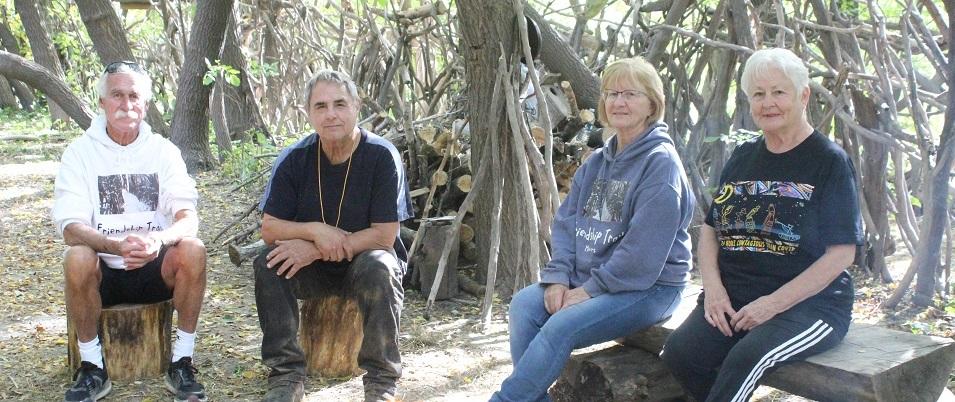Sunny skies and warm fall temperatures created the perfect reason for Ritchot residents to get outdoors on September 30 for the National Day of Truth and Reconciliation (NDTR). To encourage them, the RM created story walks along trails in Grande Pointe, Ile des Chenes, Ste. Agathe, and St. Adolphe.
“The story walk is something that was started by a librarian down in the U.S.,” says Shane Ray, director of Ritchot Recreation Services. “Basically, you take [pages of] stories and put them on sign boards and line them up along a trail so families can walk and be active while reading the story. Hopefully the stories that we’re doing here today spark a conversation between children and adults. In some cases, the adults help educate the children and also the opposite. Our schools are doing a great job in educating our kids in Truth and Reconciliation, so maybe there’s some education that can go back the other way.”
The story walk in St. Adolphe couldn’t have had a more fitting setting than the rustic Friendship Trail. Marked by an orange shirt at the trail’s north entrance, a length of winding trail was bordered on both sides by beautifully illustrated storybook pages, English language on the left and French on the right.
The pages told the story of Phyllis Webstad, a residential school survivor whose prized orange shirt was taken from her on her first day of school, never to be returned.
Since that time, the orange shirt has become a symbolic reminder of the atrocities faced by so many young Indigenous children over the century-long existence of residential schools.
Partnering on the theme, the Ste. Adolphe Friendship Trail volunteer group had much more in store for families visiting the trail that day.
At the peak of the dike stood an authentic Red River oxcart, on display to commemorate the arrival of the Metis to Manitoba.
A fire blazed in the firepit just inside the south entrance to Friendship Trail, beckoning families to spend some time sipping coffee or enjoying a picnic lunch. Across the path, two skilled chainsaw carvers were busy giving demonstrations on their woodworking craft.
Along the trails, children participated in a scavenger hunt, finding bags of treats tucked away in tree branches or in the hand-built structures that were created especially for trail users to enjoy.
Chrissy Price was one mom enjoying the trail that day with her nine-year-old twins. For Price, it was the second year of active participation in NDTR events with her kids. In 2021, they joined the march through Winnipeg that culminated with a drum circle in the park.
“[To participate] means acknowledging the genocides that happened in the past and striving to do better for future generations,” Price says.
Truth and Reconciliation, she adds, has opened the door to talk openly with her children about Canada’s less than stellar treatment of its Indigenous peoples throughout history.
The Friendship Trail committee consists of five local seniors: Gerry Lagasse, Bill Gibson, Rick and Henriette Collette, and Dianne Delorme. Their shared Metis heritage brings the desire for truth and reconciliation so much closer to home for this crew.
“It’s time to acknowledge what happened,” says Rick Collette.
“Everything that happened in the residential schools,” Delorme expounds, “all the abuse and being taken away from their parents at early ages and not being allowed to continue their culture… It’s heartbreaking.”
The team of active seniors had to work extra hard this summer getting the trail back into shape after the devastating effects of this year’s flood. Lagasse busied himself applying for grants to assist in adding new trail features and preparing for NDTR.
In total, the committee received $2,400 from Indigenous Northern Affairs and the David Suzuki Foundation in partnership with the National Healing Forest Initiative.
“Forests have a healing, spiritual, calming, and nurturing effect on people,” says the National Healing Forest website. “The National Healing Forest initiative is an invitation to Indigenous and non-Indigenous communities, institutions, and individuals to create green spaces across Canada to honour residential school victims, survivors, and their families, as well as murdered and missing Indigenous women and girls, and children who have been or were removed from their families.”1
Indeed, the Friendship Trail fits perfectly the expectations of such an initiative. Its various trails lead through thick forest canopies and branch out here and there to end in serene riverside meditation points.
“This is a gorgeous area because in the morning you can see the deer on the other side,” Lagasse says from one of those points along the river. “Usually the bald eagles are sitting [up in the trees]. It’s so peaceful here.”
He recalls a woman who used to come here regularly as she travelled back and forth to Winnipeg for cancer treatment. She would stop at the trail on her way home, collecting her thoughts around the fire and communing with nature along the trails.
Lagasse is already looking for ways to expand on the theme for next year’s NDTR. He hopes to have a tipi set up and locate some Indigenous speakers willing to share their stories.
This year, with at least 400 people coming out to commemorate Truth and Reconciliation along the Friendship Trail, he’s considering it a success.
“As a group, it’s great when you can all work together and create something that people can enjoy,” Lagasse says. “This trail is not about us. It’s about the community.”


